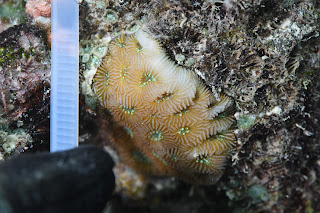Palau paper number one

This morning, I received a text from my collaborator and former postdoc, Hanny: "IT IS OUT!!!!" The "it" in her exclamation needed no explanation. Neither did the ambiguous adjective "out." She was referring to the paper she had worked immensely hard on over the last several years. This paper is the first to report on our team's research in Palau, and I am immensely glad to see it in print. The story of this paper is a story of scientific women. It actually starts with Anne Cohen, another scientist at WHOI, whose lab had been going to Palau for years. They noticed that corals in the semi-enclosed Rock Island lagoons in southern Palau had fewer stress bands than other corals. They bleached less often. This was completely counter-intuitive, because the lagoons are actually warmer than the surrounding reefs. What could be the explanation? Hanny had an idea - she thought the genetics of those corals could possibly explain the differences in their bleachi




.jpg)










